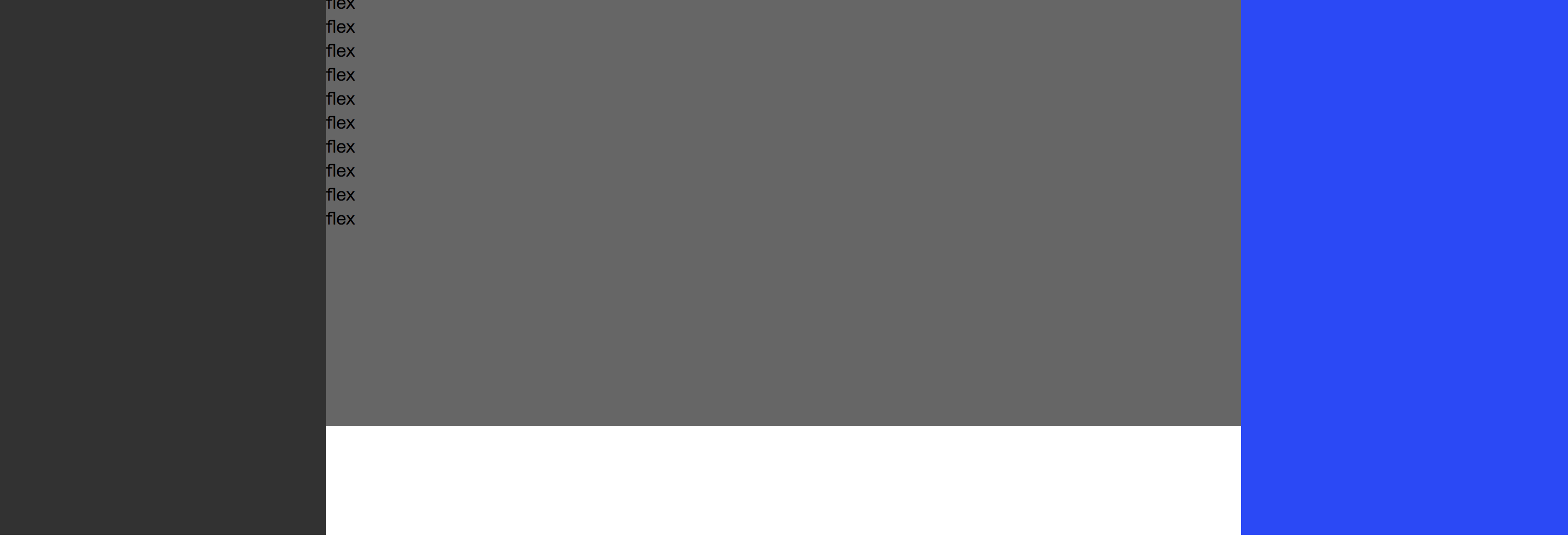常用CSS布局(1.左右高度固定,中间自适应 2.上下高度固定,中间自适应)
1.左右高度固定,中间自适应
一般有五种方法:
第一种利用浮动:
分为两种情况:
文本高度未超过自适应div最小高度:
<section class="layout float">
<style>
.layout.float .left{
float: left;
width: 300px;
background-color: #333;
}
.layout.float .right{
float: right;
width: 300px;
background-color: #333fff;
}
.layout.float .center{
background-color: #666;
}
</style>
<article>
<div class="left">
<p>111</p>
</div>
<div class="right"></div>
<div class="center">
<p>浮动</p>
</div>
</article>
</section>

文本高度超过自适应div最小高度:
<!-- 1.利用浮动 -->
<!-- 1.利用浮动 -->
<section class="layout float">
<style>
.layout.float .left{
float: left;
width: 300px;
background-color: #333;
}
.layout.float .right{
float: right;
width: 300px;
background-color: #333fff;
}
.layout.float .center{
background-color: #666;
}
</style>
<article>
<div class="left">
<p>111</p>
<p>111</p>
<p>111</p>
<p>111</p>
<p>111</p>
<p>111</p>
<p>111</p>
</div>
<div class="right"></div>
<div class="center">
<p>浮动</p>
<p>浮动</p>
<p>浮动</p>
<p>浮动</p>
<p>浮动</p>
<p>浮动</p>
<p>浮动</p>
<p>浮动</p>
<p>浮动</p>
<p>浮动</p>
<p>浮动</p>
<p>浮动</p>
</div>
</article>
</section>
样式:

第二种利用绝对定位:
文本高度未超过自适应div最小高度:
<section class="layout position">
<style>
.layout.position article div{
position: absolute;
}
.layout.position .left{
left: 0;
width: 300px;
background-color: #333;
}
.layout.position .right{
right: 0;
width: 300px;
background-color: #333fff;
}
.layout.position .center{
left: 300px;
right: 300px;
background-color: #666;
}
</style>
<article>
<div class="left"></div>
<div class="center">
<p>定位</p>
</div>
<div class="right"></div>
</article>
</section>
文本高度超过自适应div最小高度:
 position
position
第三种利用flex布局:
文本高度未超过自适应div最小高度:

<section class="layout flex">
<style>
.layout.flex{
margin-top: 140px;
}
.layout.flex article{
display: flex;
}
.layout.flex .left{
width: 300px;
background-color: #333;
}
.layout.flex .right{
width: 300px;
background-color: #333fff;
}
.layout.flex .center{
flex: 1;
background-color: #666;
}
</style>
<article>
<div class="left"></div>
<div class="center">
<p>flex</p>
</div>
<div class="right"></div>
</article>
</section>
文本高度超过自适应div最小高度:
 flex
flex
<!-- 3.利用flex布局 -->
<section class="layout flex">
<style>
.layout.flex{
margin-top: 140px;
}
.layout.flex article{
display: flex;
}
.layout.flex .left{
width: 300px;
height: 500px;
background-color: #333;
}
.layout.flex .right{
width: 300px;
background-color: #333fff;
}
.layout.flex .center{
flex: 1;
background-color: #666;
height: 400px;
}
</style>
<article>
<div class="left"></div>
<div class="center">
<p>flex</p>
<p>flex</p>
<p>flex</p>
<p>flex</p>
<p>flex</p>
<p>flex</p>
<p>flex</p>
<p>flex</p>
<p>flex</p>
<p>flex</p>
</div>
<div class="right"></div>
</article>
</section>

第四种利用table属性:
文本高度未超过自适应div最小高度:

<section class="layout table">
<style>
.layout.table article{
height: 100px;
display: table;
width: 100%;
}
.layout.table article>div{
display: table-cell;
}
.layout.table .left{
width: 300px;
background-color: #333;
}
.layout.table .right{
width: 300px;
background-color: #333fff;
}
.layout.table .center{
background-color: #666;
}
</style>
<article>
<div class="left"></div>
<div class="center">
<p>table</p>
</div>
<div class="right"></div>
</article>
</section>
文本高度超过自适应div最小高度:

<section class="layout table">
<style>
.layout.table article{
height: 100px;
display: table;
width: 100%;
}
.layout.table article>div{
display: table-cell;
}
.layout.table .left{
width: 300px;
height: 500px;
background-color: #333;
}
.layout.table .right{
width: 300px;
background-color: #333fff;
}
.layout.table .center{
background-color: #666;
height: 300px;
}
</style>
<article>
<div class="left"></div>
<div class="center">
<p>table</p>
<p>table</p>
<p>table</p>
<p>table</p>
<p>table</p>
<p>table</p>
<p>table</p>
<p>table</p>
<p>table</p>
</div>
<div class="right"></div>
</article>
</section>

第五种利用网格grid布局:
文本高度未超过自适应div最小高度:

<section class="layout grid">
<style>
.layout.grid article{
min-height: 100px;
display: grid;
grid-template-rows: 100px;
grid-template-columns: 300px auto 300px;
}
.layout.grid .left{
background-color: #333;
}
.layout.grid .right{
background-color: #333fff;
}
.layout.grid .center{
background-color: #666;
}
</style>
<article>
<div class="left"></div>
<div class="center">
<p>grid</p>
</div>
<div class="right"></div>
</article>
</section>
文本高度超过自适应div最小高度:

<!-- 5.利用grid属性 -->
<section class="layout grid">
<style>
.layout.grid article{
min-height: 100px;
display: grid;
grid-template-rows: 100px;
grid-template-columns: 300px auto 300px;
}
.layout.grid .left{
background-color: #333;
}
.layout.grid .right{
background-color: #333fff;
}
.layout.grid .center{
background-color: #666;
}
</style>
<article>
<div class="left"></div>
<div class="center">
<p>flex</p>
<p>flex</p>
<p>flex</p>
<p>flex</p>
<p>flex</p>
<p>flex</p>
<p>flex</p>
<p>flex</p>
<p>flex</p>
<p>flex</p>
</div>
<div class="right"></div>
</article>
</section>

根据以上示例,我们可以总结他们各自存在什么优缺点:
当div中的文本元素的高度超过容器div的高度时,
1.定位,网格布局不能撑高所在div的高度
2.浮动只能撑高所在div的高度
3.flex,和表格可以撑高整个div的高度
4.但是table不能设置每列的高度,始终高度都是一致的,为所写div的最大高度,
5.所以flex布局是最好的自适应布局
2.上下高度固定,中间自适应
第一种利用table:

<section class="layouttop">
<style>
/*没有文本内容时,盒子需要被撑开,每个盒子都要被赋予100%的高度*/
html,body,.layouttop,.layouttop article{
height: 100%;
}
/*可以被内容撑开*/
.layouttop article{
display: table;
width: 100%;
}
.layouttop article div{
display: table-row;
}
.layouttop .top{
height: 200px;
background-color: #787878;
}
.layouttop .bottom{
height: 200px;
background-color: #565656;
}
.layouttop .middle{
background-color: #cd4d5d;
}
</style>
<article>
<div class="top">11</div>
<div class="middle">
<p>table</p>
<p>table</p>
<p>table</p>
<p>table</p>
<p>table</p>
<p>table</p>
</div>
<div class="bottom">22</div>
</article>
</section>
第二种利用flex:

<!-- 上下高度固定,中间自适应 -->
<section class="layouttop">
<style>
/*flex上下自定义定位中,每个盒子都要被赋予100%的高度*/
/*html,body,.layouttop,article{
height: 100%;
}*/
/*可以被内容撑开*/
.layouttop article{
display: flex;
flex-direction: column;
}
.layouttop .top{
height: 100px;
background-color: #787878;
}
.layouttop .bottom{
height: 100px;
background-color: #565656;
}
.layouttop .middle{
flex: 1;
background-color: #cd4d5d;
}
</style>
<article>
<div class="top"></div>
<div class="middle">
<p>flex</p>
<p>flex</p>
<p>flex</p>
<p>flex</p>
<p>flex</p>
<p>flex</p>
<p>flex</p>
<p>flex</p>
<p>flex</p>
<p>flex</p>
</div>
<div class="bottom"></div>
</article>
</section>
第三种利用绝对定位布局:

<!-- 通过绝对定位和固定定位实现 -->
<section class="layouttop">
<style>
/*flex上下自定义定位中,每个盒子都要被赋予100%的高度*/
/*html,body,.layouttop,.layouttop article{
height: 100%;
}*/
/*可以被内容撑开*/
.layouttop .top{
height: 100px;
top: 0;
background-color: #787878;
position: fixed;
width: 100%;
}
.layouttop .bottom{
height: 100px;
bottom: 0;
background-color: #565656;
position: fixed;
width: 100%;
}
.layouttop .middle{
top: 100px;
bottom: 100px;
background-color: #cd4d5d;
width: 100%;
position: absolute;
/*当文本内容超出自定义高度时,出现自定义滚动条*/
overflow: auto;
}
</style>
<article>
<div class="top"></div>
<div class="middle">
<p>position</p>
<p>position</p>
<p>position</p>
<p>position</p>
<p>position</p>
<p>position</p>
<p>position</p>
<p>position</p>
<p>position</p>
<p>position</p>
<p>position</p>
<p>position</p>
<p>position</p>
<p>position</p>
<p>position</p>
<p>position</p>
<p>position</p>
<p>position</p>
<p>position</p>
<p>position</p>
<p>position</p>
<p>position</p>
<p>position</p>
<p>position</p>
<p>position</p>
<p>position</p>
<p>position</p>
<p>position</p>
<p>position</p>
<p>position</p>
</div>
<div class="bottom"></div>
</article>
</section>
第四种利用grid网格布局:
 grid
grid



